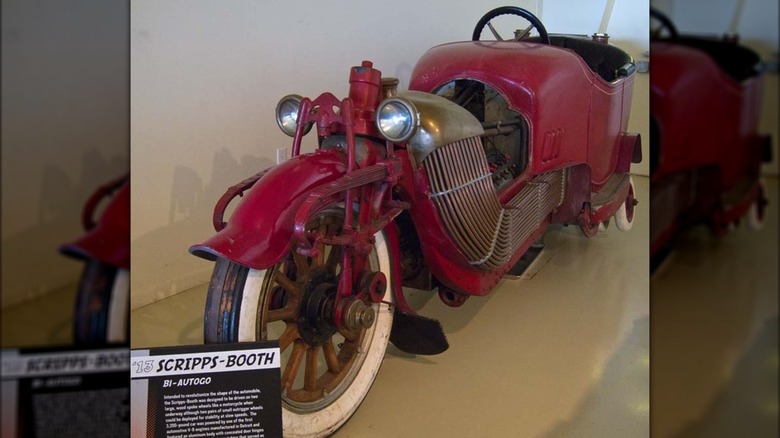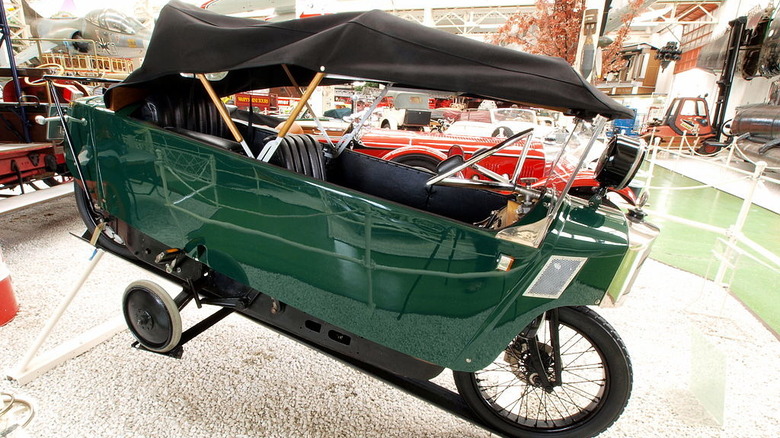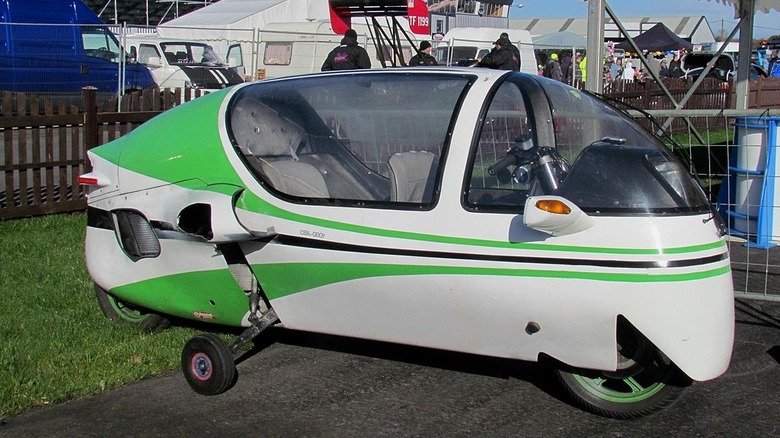5 Of The Most Bizarre Enclosed Motorcycles Ever Built
An enclosed (or cabin) motorcycle is just your basic motorcycle capped by a roof or hull enclosure. But isn't the whole point of a bike to rip down the road with the wind whipping through your hair? Yes, it is. Then why not just drive a car? That's a reasonable question. To which we say, when people are left to their own devices — whether through necessity (which we all know is the mother of invention) or just to say they did it — will more often than not take things to the next level.
Believe it or not, the concept may go back as far as 1913, but most certainly has existed since the 1920s. In the late '30s, a Czechoslovakian aeronautical engineer developed a cheaply built vehicle to get people around in all types of weather. In the 1950s, East German manufacturer NSU latched on to the idea and made several racing bikes known as "flying hammocks," which placed the rider in a similar sitting position as in a hammock. When fully enclosed, the vehicles looked like torpedoes and, not surprisingly, broke world speed records on the Bonneville Salt Flats in Utah.
The concept never really caught on, and over the decades, a few bizarre cabin motorcycles have come to fruition. We're not talking about scooters, tuk-tuks, or other three-wheeled vehicles you can drive on the street, mind you, but real-deal two-wheeled beasties.
Scripps-Booth Bi-Autogo
Let's start with the Scripps-Booth Bi-Autogo, which – technically speaking – appears to be (probably) the very first enclosed cabin motorcycle. It's unequivocally the very first V8-powered vehicle of any kind built in Detroit. You read that right — the first (ever), but certainly not one of the greatest American V8 engines ever made.
It was designed by James Scripps-Booth, the oldest child and heir to the Scripps publishing fortune. He was an artist who fancied himself a (self-taught) mechanical engineer and automotive designer, going so far as to create two vehicle-oriented companies. His cyclecar venture went under quickly, but that quickly turned into an automobile business, which General Motors bought and ran until 1922.
The Bi-Autogo rode on a pair of 37-inch wooden wagon wheels (like a motorcycle) and weighed 3,200 pounds (like a car). Other car-esque features included a three-person cockpit (one in front driving, two behind) with folding armrests (another first), hidden door hinges (yet another first), and a steering wheel (instead of handlebars), complete with a horn button (also a first).
Time Magazine put it best when it said it had "enough copper tubing to provide every hillbilly in the Ozarks with a still." All that copper was attached to a 6.3-liter V8 that managed just 45 horsepower. While moving along at slower speeds, outrigger-like training wheels popped out to keep it from tipping over. Once at cruising speed, they were retracted. After just one prototype was built (for a staggering $25,000), Scripps-Booth moved on to another cyclecar called the Rocket. The Bi-Autogo can be seen at the Detroit Historical Society.
[Featured image by HopsonRoad via Wikimedia Commons | Cropped and scaled | CC BY-SA 3.0]
Mauser Einspurauto / Monotrace
According to sources, the 1921 Mauser Einspurauto may have been a design based on the American cyclecars from the previous decade. The word "einspurauto" actually means "single-track car" in German, and during the early '20s, several European companies began making these single-track runabouts.
At the time, Gustav Winkler worked for Mauser, a German arms manufacturer established in 1811. It was famous for its bolt-action rifles and semi-automatic pistols. Factoid: the Mauser C96 was the real-life base pistol used to make Han Solo's "BlasTech DL-44" prop blaster in the "Star Wars" films (which sold for a world record-breaking $1,057,500 in 2022).
The Einspurauto was first shown at the German Motor Show in 1921 but didn't enter production until 1924. It was powered by BMW's M2B15 engine, the company's first four-stroke boxer twin-cylinder. That same engine was used by several other bike builders of the day, including Helios and Victoria, and was the basis for the engine in BMW's first bike, the R32.
It's believed that Atlantic AG für Automobilbau built the Mauser runabouts in Berlin Tempelhof, of which Joseph Popp (of BMW) was a shareholder. Atlantic also made a single-track vehicle called the Einspurwagen. Mauser eventually sold production rights to the French company Mécanicarm (in St. Etienne, France), where it built a line called Monotrace ("single-track" in French). This tandem two-seater also featured outrigger-style training wheels and was powered by a horizontal single-cylinder water-cooled 520 cc engine.
[Featured image by AlfvanBeem via Wikimedia Commons | Cropped and scaled | CC BY-SA 1.0]
Anderlé Dálník
No, not a Dalek, which appeared in the British "Doctor Who" television series, but a Dálník, a version of a cabin motorcycle designed and built by the aforementioned Czechoslovakian aeronautical engineer Jan Anderle. "Dálník" is a Czech term coined by Anderlé that joined the word "dálka" (distance) and "dálnice" (highway). Anderle loved to fly but was grounded when the Nazis occupied the country during World War II, so he set his sights on building something that could give him the same freedom.
By all accounts, Anderlé built his first Dálník prototype in 1937, with a working model showing up not long after. The body was constructed by Sodomka and powered by a twin Jawa 561 cc Minor engine producing 19.5 hp and a top speed of 74 mph. Much like a motorcycle, the Dálník was driven with handlebars. Like other enclosed bikes, outrigger wheels helped keep the vehicle upright at slow speeds or when standing still.
After the war, Anderlé went back to flying. After taking an unauthorized trip to Africa, he returned, was charged with treason, and spent the next 15 years in jail. Upon his release, he was not allowed to fly, and only after moving to France was he able to take to the skies again.
Reportedly, he eventually met (and helped) Swiss businessman Arnold Wagner, who would go on to build the next enclosed Dálník (if you will) on our list, the Peraves Oekomobil.
Peraves Oekomobil / EcoMobile / MonoTracer / Monoracer
When Swiss Air 747 pilot and engineer Arnold Wagner started Peraves, it built gliders. As a motorcycle enthusiast as well, he was inspired to create one that used fewer resources and was more useful in all the elements. One story says this inspiration came after a motorcyclist passed him one morning on the Autobahn. In contrast, another says it evolved after he read a report published in 1972 called "The Limits to Growth" by the Club of Rome (a global think tank), stating the planet likely couldn't support our way of life at its current rate.
Other sources say that as Wagner began researching the concept more thoroughly in the mid-1970s, he stumbled upon the Dálník, contacted Jan Anderlé, and absorbed as much as he could before Anderlé died in 1982. Whatever the case, Cycle World wrote an article on the Peraves Oekomobil in October 1988, an 850-pound, 12-foot-long, fully enclosed motorcycle that, like others before it, used retractable outrigger "stabilizer" wheels to keep it from tipping over.
Wagner built it from various parts taken off a factory BMW K100 motorcycle, including wheels, front fork, rear suspension, and even the instruments and controls. The monocoque body was built using Kevlar and fiberglass fastened with epoxy resin (like gliders). He used the K100's fuel-injected, four-cylinder, liquid-cooled, 90-horsepower motor and claimed it could do "at least 160" mph (50 mph with the stabilizer wheels down). Ten production models sold for approximately $42,000.
The name was changed to EcoMobile, then MonoTracer (in 2006), and is now the Monoracer — it's available in a few different versions, including an electric model with a price of nearly $87,000.
[Featured image by Ozzy Delaney via Wikimedia Commons | Cropped and scaled | CC BY-SA 2.0]
Lit C1
Lastly, we have the Lit C1, an autonomous-balancing electric vehicle (AEV) from San Francisco-based startup Lit Motors. Well, we will if it ever hits the streets. See, the C1 first promised to bring "Tron" to reality way back in 2012 with an initial cost of $24,000 and a launch date of 2014.
After years without a single C1 hitting the road, CEO Danny Kim was forced to reimburse customers. Then, in early 2023, pre-orders for the C1 reopened, now with an estimated MSRP of $32,000. Another year later, it's still in the pre-ordering phase, one that entails buying a company T-shirt (for $250) with an "Official Reservation Certificate" entitling you to "reserve a place in the queue 6–12 months before production." Make of that what you will.
The C1 has incredible potential because it's a genuine, fully enclosed motorcycle that automatically self-balances. It does this using two large gyroscopes (typically found in satellites) mounted on the floor, making it very difficult to topple over, thus doing away with the outrigger training wheels (and kickstand). In an accident, the gyros absorb and significantly reduce the impact's force. It will protect passengers by working with other safety features (i.e., seatbelts, steel-reinforced chassis/doors, and front and side airbags).
The C1 can carry a driver and one passenger and is steered like a motorcycle, sustaining lean/tilt angles up to 45 degrees. It uses a 13Kwh battery pack to power a 72Kw motor, can go from zero to 60 mph in five seconds, and reach speeds over 100 mph. Additionally, it is supposed to have other creature comforts like scissor doors, windshield wipers, a stereo system, air conditioning, etc.
With just a few prototypes built, only time will tell if we'll ever see Lit's C1.



